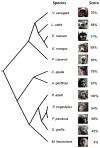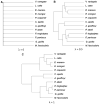How does cognition evolve? Phylogenetic comparative psychology
- PMID: 21927850
- PMCID: PMC3980718
- DOI: 10.1007/s10071-011-0448-8
How does cognition evolve? Phylogenetic comparative psychology
Abstract
Now more than ever animal studies have the potential to test hypotheses regarding how cognition evolves. Comparative psychologists have developed new techniques to probe the cognitive mechanisms underlying animal behavior, and they have become increasingly skillful at adapting methodologies to test multiple species. Meanwhile, evolutionary biologists have generated quantitative approaches to investigate the phylogenetic distribution and function of phenotypic traits, including cognition. In particular, phylogenetic methods can quantitatively (1) test whether specific cognitive abilities are correlated with life history (e.g., lifespan), morphology (e.g., brain size), or socio-ecological variables (e.g., social system), (2) measure how strongly phylogenetic relatedness predicts the distribution of cognitive skills across species, and (3) estimate the ancestral state of a given cognitive trait using measures of cognitive performance from extant species. Phylogenetic methods can also be used to guide the selection of species comparisons that offer the strongest tests of a priori predictions of cognitive evolutionary hypotheses (i.e., phylogenetic targeting). Here, we explain how an integration of comparative psychology and evolutionary biology will answer a host of questions regarding the phylogenetic distribution and history of cognitive traits, as well as the evolutionary processes that drove their evolution.
Figures



References
-
- Abouheif E. A method for testing the assumption of phylogenetic independence in comparative data. Evol Ecol Res. 1999;1:895–909.
-
- Albiach-Serrano A, Guillen-Salazar F, Call J. Mangabeys (Cercocebus torquatus lunulatus) solve the reverse contingency task without a modified procedure. Anim Cogn. 2007;10(4):387–396. - PubMed
-
- Amici F, Aureli F, Call J. Fission-fusion dynamics, behavioral flexibility, and inhibitory control in primates. Curr Biol. 2008;18(18):1415–1419. - PubMed
-
- Amici F, Aureli F, Call J. Monkeys and Apes: are their cognitive skills really so different? Am J Phys Anthropol. 2010;143(2):188–197. - PubMed
Publication types
MeSH terms
Grants and funding
LinkOut - more resources
Full Text Sources

